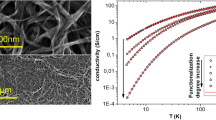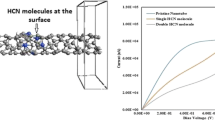Abstract
The in situ Raman spectroscopy technique was used to investigate the ion transport and to determine the concomitant electrochemical tuning of Fermi level in single-wall carbon nanotubes. The variation of structural bonding in a single-wall carbon nanotube bundle dipped in aqueous alkaline earth halide electrolyte such as CaCl2 with electrochemical biasing was monitored. This is because Raman scattering can detect changes in C–C bond length through radial breathing mode (RBM) at ≈184 cm−1, which varies inversely with the nanotube diameter and the G band at ≈1590 cm−1, varying with the axial bond length. Consistent reversible and substantial variation in Raman intensity of both modes was induced by electrode potential point at the fine and continuous tuning (alternatively, emptying/depleting or filling) of the specific bonding and anti-bonding molecular states. Qualitatively, the results were explained in terms of changes in the energy gap occurring between the one-dimensional van Hove singularities present in the electron density of states, possibly arising due to the alterations in the overlap integral of π bonds between the p orbitals of the adjacent carbon atoms. We estimated the extent of variation of the absolute potential of the Fermi level and overlap integral (γ0) between the nearest-neighbor carbon atoms by modeling the electrochemical potential dependence of Raman intensity. Observations also suggested that the work function of the tube becomes larger for the metallic nanotubes in contrast to the simultaneously present semiconducting nanotubes.
Similar content being viewed by others
Change history
01 September 2007
This article has been retracted. Please see the Retraction Notice for more detail: https://doi.org/10.1557/JMR.2007.0087r
References
M. Terrones, F. Banhart, N. Grobert, J.C. Charlier, H. Terrones, and P.M. Ajayan: Molecular junctions by joining single-walled carbon nanotubes. Phys. Rev. Lett. 89, 075505 (2002).
G. Sun, M. Nicklaus, and M. Kertesz: Dekker Encyclopedia of Nanoscience and Nanotechnology (New York, 2004), p. 3605.
M.M.J Treacy, T.W. Ebbesen, and J.M. Gibson: Exceptionally high Young’s modulus observed for individual carbon nanotubes. Nature 381, 678 (1996).
B. Gao, A. Kelinhammes, X.P. Tang, C. Bower, Y. Wu, and O. Zhou: Electrochemical intercalation of single-walled carbon nanotubes with lithium. Chem. Phys. Lett. 307, 153 (1999).
J. Liu, G. Rinzler, H. Dai, J.H. Hafner, R.K. Bradley, P.J. Boul, A. Lu, T. Iverson, K. Shelimov, C.B. Huffman, F. Rodriguez-Macias, Y. Shon, T.R. Lee, D.T. Colbert, and R.E. Smalley: Fullerene pipes. Science 280, 1253 (1998).
J. Li, H.T. Ng, A. Cassell, W. Fan, H. Chen, Q. Ye, J. Koehne, J. Han, and M. Meyappan: Carbon nanotube nanoelectrode array for ultrasensitive DNA detection. Nano Lett. 3, 597 (2003).
C.L. Cheung, J.H. Hafner, and C.M. Lieber: Carbon nanotube atomic force microscopy tips: Direct growth by chemical vapor deposition and application to high-resolution imaging. Proc. Natl. Acad. Sci. USA 97, 3809 (2000).
S. Gupta, M.H. Hughes, A.H. Windle, and J. Robertson: Charge transfer in carbon nanotube actuators investigated using in situ Raman spectroscopy. J. Appl. Phys. 95, 2038 (2004).
M. Hughes, M.S.P Shaffer, A.C. Renouf, C. Singh, G.Z. Chen, D.J. Fray, and A.H. Windle: Electrochemical capacitance of nanocomposite films formed by coating aligned arrays of carbon nanotubes with polypyrrole. Adv. Mater. 14, 382 (2002).
J.C. Charlierand Ph. Lambin: Electronic structure of carbon nanotubes with chiral symmetry. Phys. Rev. B 57, R15037 (1998).
G.S. Duesberg, I. Loa, M. Burghard, K. Syassen, and S. Roth: Polarized Raman spectroscopy on isolated single-wall carbon nanotubes. Phys. Rev. Lett. 85, 5436 (2000).
J.W.G. Wildöer, L.C. Venema, A.G. Rinzler, R.E. Smalley, and C. Dekker: Electronic structure of atomically resolved carbon nanotubes. Nature 391, 59 (1998).
T.W. Odom, J.L. Huang, P. Kim, and C.M. Lieber: Atomic structure and electronic properties of single-walled carbon nanotubes. Nature 391, 62 (1998).
M.J. O’Connell, S.M. Bachilo, C.B. Huffman, V.C. Moore, M.S. Strano, E.H. Haroz, K.L. Rialon, P.J. Boul, W.H. Noon, C. Kittrell, J.P. Ma, R.H. Hauge, R.B. Weisman, and R.E. Smalley: Band gap fluorescence from individual single-walled carbon nanotubes. Science 297, 593 (2002).
D. Lovall, M. Buss, E. Graugnard, R.P. Andres, and R. Reifenberger: Electron emission and structural characterization of a rope of single-walled carbon nanotubes. Phys. Rev. B 61, 5683 (2000).
S. Suzuki, C. Bower, Y. Watanabe, and O. Zhou: Work functions and valence band states of pristine and Cs-intercalated single-walled carbon nanotube bundles. Appl. Phys. Lett. 76, 4007 (2000).
M. Shiraishiand M. Alta: Work function of carbon nanotubes. Carbon 39, 1913 (2001).
C.L. Kaneand E.J. Mele: Size, shape, and low energy electronic structure of carbon nanotubes. Phys. Rev. Lett. 78, 1932 (1997).
Y. Wada: New Horizon in Low-dimensional Electron Systems, Physics and Chemistry of Material with Low-dimensional structures edited by H. Aoki, M. Tsukada, M. Schluter, F. Levy (Kluwer Academic, Boston, MA, 1991), pp. 415–432.
M.S. Dresselhausand P.C. Eklund: Phonons in carbon nanotubes. Adv. Phys. 49, 705 (2000).
M.R. Falvo, G.J. Curry, R.M. Taylor, V. Chi, F.P. Brooks, S. Washburn, and R. Superfine: Bending and buckling of carbon nanotubes under large strain. Nature 389, 582 (1997).
R.H. Baughman, C. Cui, A.A. Zakhidov, Z. Iqbal, J.N. Barisci, G.M. Spinks, G.G. Wallace, A. Mazzoldi, D. De Rossi, A.G. Rinzler, O. Jaschinski, S. Roth, and M. Kertesz: Carbon nanotube actuators. Science 284, 1340 (1999).
J.E. Huber, N.A. Fleck, and M.F. Ashby: The selection of mechanical actuators based on performance indices. Proc. R. Soc. London, Ser. A 453, 2185 (1997).
T.W. Ebbesen, H.J. Lezec, H. Hiura, J.W. Bennett, H.F. Ghaemi, and T. Thio: Electrical conductivity of individual carbon nanotubes. Nature 382, 54 (1996).
M.S. Dresselhausand G. Dresselhaus: Light scattering in graphite intercalation compounds, in Topics in Applied Physics Series, Vol. 53, edited by M. Cardonaand G. Güntherodt (Springer-Verlag, Berlin, Germany, 1982), p. 3.
S. Gupta, M. Hughes, A.H. Windle, and J. Robertson: In situ Raman spectro- electrochemistry study of single-wall carbon nanotube mat. Diamond Relat. Mater. 13, 1314 (2003).
W. Zhou, J. Vavro, N.M. Nemes, J.E. Fischer, F. Borondics, K. Kamarás, and D.B. Tanner: Charge transfer and Fermi level shift inp -doped single-walled carbon nanotubes. Phys. Rev. B 71, 205423 (2005).
S. Kazaoui, N. Minami, H. Kataura, and Y. Achiba: Electronic Properties of Novel Materials—Molecular Nanostructures, edited by H. Kuzmanyand S. Roth (AIP Conf. Proc. 544, AIP, New York, 2000), pp. 400–403.
P.R. Gill, W. Murray, and M.H. Wright: The Levenberg-Marquardt Method, Sec. 4.7.3, in Practical Optimization (Academic Press, London, UK, 1981), pp. 136–137.
A. Jorio, R. Saito, J.H. Hafner, C.M. Lieber, M. Hunter, T. McClure, G. Dresselhaus, and M.S. Dresselhaus: Structural (n, m) determination of isolated single-wall carbon nanotubes by resonant Raman scattering. Phys. Rev. Lett. 86, 1118 (2001).
A.M. Rao, E. Richter, S. Bandow, B. Chase, P.C. Eklund, K.A. Williams, S. Fang, K.R. Subbaswamy, M. Menon, A. Thess, and R.E. Smalley: Diameter-selective Raman scattering from vibrational modes in carbon nanotubes. Science 275, 187 (1997).
S. Reich, C. Thomsen, and P. Ordejón: Elastic properties of carbon nanotubes under hydrostatic pressure. Phys. Rev. B 65, 3407 (2002).
J. Sandler, M.S.P Shaffer, A.H. Windle, M.P. Halsall, M.A. Montes-Morán, C.A. Cooper, and R.J. Young: Variations in the Raman peak shift as a function of hydrostatic pressure for various carbon nanostructures: A simple geometric effect. Phys. Rev. B 67, 035417 (2003).
C.P. An, Z.V. Zardeny, Z. Iqbal, G. Spinks, R.H. Baughman, and A. Zakhidov: Raman scattering study of electrochemically doped single wall nanotubes. Synth. Met. 116, 411 (2001).
L. Kavan, P. Rapta, L. Dunsch, M. J. Bronikowski, P. Willis, and R. E. Smalley: Electrochemical tuning of electronic structure of single-walled carbon nanotubes: In-situ Raman and vis-NIR study. J. Phys. Chem. 105 B,10764 (2001).
G.S. Duesburg: unpublished results.
K. Murakoshiand K. Okazaki: Electrochemical potential control of isolated single-walled carbon nanotubes on gold electrode. Electrochem. Acta 50, 3069 (2005).
W.H. Robertsonand M.A. Johnson: Molecular aspects of halide ion hydration: The cluster approach. Ann. Rev. Phys. Chem. 54, 173 (2003).
B. Ruzicka, L. Degiorgi, R. Gaal, L. Thien-Nga, R. Basca, J.P. Salvetat, and L. Forro: Optical and dc conductivity study of potassium-doped single-walled carbon nanotube films. Phys. Rev. B 61, R2468 (2000).
S. Kazaoui, N. Minami, N. Matsuda, H. Kataura, and Y. Achiba: Electrochemical tuning of electronic states in single-wall carbon nanotubes studied by in situ absorption spectroscopy and ac resistance. Appl. Phys. Lett. 78, 3433 (2001).
S. Trasatti: The concept of absolute electrode potential, an attempt at a calculation. J. Electroanal. Chem. 52, 313 (1974).
R. Parsons: Standard Potentials in Aqueous Solution, edited by A.J. Bard, R. Parsonsand J. Jordan (Marcel Dekker, New York and Basel, 1985).
S. Ghosh, A.K. Sood, and C.N.R Rao: Electrochemical tuning of band structure of single-walled carbon nanotubes probed by in situ resonance Raman scattering. J. Appl. Phys. 92, 1165 (2002).
K. Okazaki, Y. Nakato, and K. Murakoshi: Absolute potential of the Fermi level of isolated single-walled carbon nanotubes. Phys. Rev. B 68, 035434 (2003).
A.M. Rao, P.C. Eklund, S. Bandow, A. Thess, and R.E. Smalley: Evidence for charge transfer in doped carbon nanotube bundles from Raman scattering. Nature 388, 257 (1997).
Author information
Authors and Affiliations
Corresponding author
About this article
Cite this article
Gupta, S. RETRACTED ARTICLE: Ion transport and electrochemical tuning of Fermi level in single-wall carbon nanotubes: In situ Raman scattering. Journal of Materials Research 22, 603–614 (2007). https://doi.org/10.1557/jmr.2007.0087
Received:
Accepted:
Published:
Issue Date:
DOI: https://doi.org/10.1557/jmr.2007.0087




